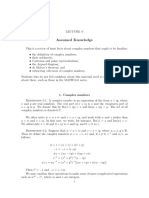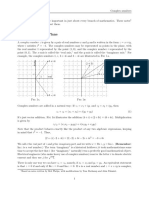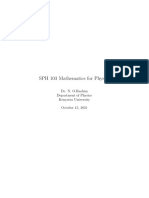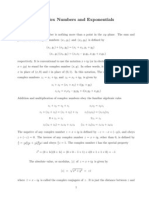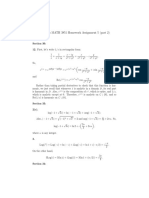0 ratings0% found this document useful (0 votes)
16 viewsComplex 2
Complex 2
Uploaded by
api-470723240This document introduces the polar form of complex numbers, which represents a complex number z as r(cosθ + i sinθ), where r is the modulus and θ is the amplitude or argument. It also defines the conjugate and exponential forms of complex numbers. Logarithms of complex numbers are many-valued functions, as log(w) = z but also log(w) = z + 2nπi for any integer n. To find the real and imaginary parts of log(x+iy)/log(2+i3), we write x+iy in polar form and take the logarithm.
Copyright:
© All Rights Reserved
Available Formats
Download as DOCX, PDF, TXT or read online from Scribd
Complex 2
Complex 2
Uploaded by
api-4707232400 ratings0% found this document useful (0 votes)
16 views1 pageThis document introduces the polar form of complex numbers, which represents a complex number z as r(cosθ + i sinθ), where r is the modulus and θ is the amplitude or argument. It also defines the conjugate and exponential forms of complex numbers. Logarithms of complex numbers are many-valued functions, as log(w) = z but also log(w) = z + 2nπi for any integer n. To find the real and imaginary parts of log(x+iy)/log(2+i3), we write x+iy in polar form and take the logarithm.
Original Title
complex 2
Copyright
© © All Rights Reserved
Available Formats
DOCX, PDF, TXT or read online from Scribd
Share this document
Did you find this document useful?
Is this content inappropriate?
This document introduces the polar form of complex numbers, which represents a complex number z as r(cosθ + i sinθ), where r is the modulus and θ is the amplitude or argument. It also defines the conjugate and exponential forms of complex numbers. Logarithms of complex numbers are many-valued functions, as log(w) = z but also log(w) = z + 2nπi for any integer n. To find the real and imaginary parts of log(x+iy)/log(2+i3), we write x+iy in polar form and take the logarithm.
Copyright:
© All Rights Reserved
Available Formats
Download as DOCX, PDF, TXT or read online from Scribd
Download as docx, pdf, or txt
0 ratings0% found this document useful (0 votes)
16 views1 pageComplex 2
Complex 2
Uploaded by
api-470723240This document introduces the polar form of complex numbers, which represents a complex number z as r(cosθ + i sinθ), where r is the modulus and θ is the amplitude or argument. It also defines the conjugate and exponential forms of complex numbers. Logarithms of complex numbers are many-valued functions, as log(w) = z but also log(w) = z + 2nπi for any integer n. To find the real and imaginary parts of log(x+iy)/log(2+i3), we write x+iy in polar form and take the logarithm.
Copyright:
© All Rights Reserved
Available Formats
Download as DOCX, PDF, TXT or read online from Scribd
Download as docx, pdf, or txt
You are on page 1of 1
Polar form of complex number
We have z = x + iy a complex number put x = rcos and y = r sin
we get z = rcos +i r sin = r(cos +i sin )
which is called the polar form of the complex number z
The angle is called the amplitude or argument of the comlex number z .
y
The angle tan 1
x
The conjugate of a complex number z is defined by z = x - iy
2
we note that z z = (x+iy)(x-iy) = x 2 +y 2 = z
z =a; represent a circle with centre origin and radius a. For each x R ,
the complex number eix is defined as eix cosx + i sinx known as Euler's formula
We note that eix = cos 2 x + sin 2 x = 1 and e ix cosx - i sinx
since we have e ix cosx - i sinx and eix cosx + i sinx
e ix eix eix e ix
we get cosx and sinx and e z = e x iy =e x (cosy +i siny)
2 2i
The complex number z = r(cos +sin ) where z = r
can be written as z = rei is called the exponential form of the comlex number.
Logrithms of comlex number
Let z and w be comlex numbers . If w = e z ,then z is called a logrithim of w .
Thus log e w = z
If w = e z , then e z 2 n i e z e 2 n i e z w
If z is logrithim of w then z +2n i is also a logrithim of w
hence logrithim is a many valued function
Q1: Find real and imaginary parts of log (x+iy)/log(2+i3)
y
Let x + iy = r(cos + sin ) so that r = x2 y 2 and = tan 1
x
= log (rei )+2n i = log r + log(ei )+2n i = log r +i +2n i
y
= log x 2 y 2 +i +2n i = log x 2 y 2 +i (tan 1 +2n )
x
y
real part = log x2 y 2 imag part = tan 1 +2n
x
You might also like
- UNSW MATH2621 Course NotesDocument205 pagesUNSW MATH2621 Course Notesparrotcup6No ratings yet
- Complex PDFDocument9 pagesComplex PDFAnonymous YRU6YtNo ratings yet
- Lecture 1 2024Document16 pagesLecture 1 2024siddhutripuramallikarjunNo ratings yet
- compleks1Document45 pagescompleks1yagmur.kumrular.0No ratings yet
- Complex Analysis I Lec NotesDocument25 pagesComplex Analysis I Lec Notesaego2972No ratings yet
- Elementary Properties of Complex NumbersDocument16 pagesElementary Properties of Complex NumbersNikhil KumarNo ratings yet
- MATH3403Document12 pagesMATH3403mangofarmergooseNo ratings yet
- MTH 324 (Complex Analysis) Lecture # 3 (Functions of A Complex Variable) FunctionDocument3 pagesMTH 324 (Complex Analysis) Lecture # 3 (Functions of A Complex Variable) Functionmy pcNo ratings yet
- Lecture 10Document9 pagesLecture 10Khabab NazirNo ratings yet
- C - Fakepathc - fakepathALL LECTURES LA and AGDocument113 pagesC - Fakepathc - fakepathALL LECTURES LA and AGOrxan MirzəzadəNo ratings yet
- Complex Number - Chapter NotesDocument17 pagesComplex Number - Chapter NotesDivyanshi VishwakarmaNo ratings yet
- 5.1 Constructing The Complex NumbersDocument26 pages5.1 Constructing The Complex Numbersmanda.charmi2003No ratings yet
- Chapter 4.indd 184 01-01-2009 11:10:44 AMDocument50 pagesChapter 4.indd 184 01-01-2009 11:10:44 AMsanjayb1976gmailcomNo ratings yet
- Complex NumbersDocument6 pagesComplex Numbers吳心No ratings yet
- Complex Numbers PDFDocument2 pagesComplex Numbers PDFAnonymous UPSvaOdq49No ratings yet
- Complex NumbersDocument11 pagesComplex Numbers1187asmaNo ratings yet
- complexDocument17 pagescomplexsbusisom129No ratings yet
- Integration in Complex VariablesDocument11 pagesIntegration in Complex Variablesiamxxxofficial86No ratings yet
- Complex NumbersDocument56 pagesComplex NumbersDave Lumas100% (3)
- SPH 103 Mathematics For Physics: Dr. N. O.Hashim Department of Physics Kenyatta University September 19, 2017Document122 pagesSPH 103 Mathematics For Physics: Dr. N. O.Hashim Department of Physics Kenyatta University September 19, 2017OGEGA KERUBONo ratings yet
- Complex Numbers Notes and Formulas PDFDocument2 pagesComplex Numbers Notes and Formulas PDFAzhar HussainNo ratings yet
- complexanalysis-Lecture2-2024Document4 pagescomplexanalysis-Lecture2-2024chingofchinaNo ratings yet
- Module-4 COMPLEX DIFFERENTIATION PDFDocument40 pagesModule-4 COMPLEX DIFFERENTIATION PDFPreetham N KumarNo ratings yet
- DR ST - ETBS204-Module - 4 (Text)Document86 pagesDR ST - ETBS204-Module - 4 (Text)Jmas HCAlsNo ratings yet
- SPH 103 Notes 21Document122 pagesSPH 103 Notes 21kabuchokaniu92No ratings yet
- AlgebraDocument97 pagesAlgebraHatim ShamsudinNo ratings yet
- Complex Number-01 - TheoryDocument30 pagesComplex Number-01 - TheoryRaju SinghNo ratings yet
- Complex Numbers PDFDocument87 pagesComplex Numbers PDFMD SHOEBUDDINNo ratings yet
- ComplexDocument33 pagesComplexDipin Preet SinghNo ratings yet
- Complex Numbers (TN)Document26 pagesComplex Numbers (TN)Raju SinghNo ratings yet
- Complex Analysis ManualDocument65 pagesComplex Analysis ManualTshiamo MotaungNo ratings yet
- 1588520304-week-1-lectureDocument8 pages1588520304-week-1-lectureUmar JalaliNo ratings yet
- Chapter 3001Document92 pagesChapter 3001jangra014100% (2)
- Solution To Complex VariablesDocument186 pagesSolution To Complex VariablesSk100% (1)
- 1 Complex Numbers1 - 1Document6 pages1 Complex Numbers1 - 1sansajjan9604No ratings yet
- Complex Numbers and ExponentialsDocument4 pagesComplex Numbers and Exponentials"The Dangerous One"No ratings yet
- Complex Numbers and Exponentials: Definition and Basic OperationsDocument8 pagesComplex Numbers and Exponentials: Definition and Basic OperationsCharlieLevittNo ratings yet
- Notes On Complex NumbersDocument8 pagesNotes On Complex NumbersPratip JanaNo ratings yet
- Complex AlgebraDocument8 pagesComplex Algebramahek19579328100% (1)
- Complex NoDocument37 pagesComplex NoSripati Jha100% (1)
- Notes1 PDFDocument22 pagesNotes1 PDFvrtvtNo ratings yet
- Maths24 13 01Document13 pagesMaths24 13 01tariq.rashidNo ratings yet
- MathsDocument13 pagesMathspopot985No ratings yet
- Mathphy 7Document25 pagesMathphy 7Manpreet SinghNo ratings yet
- U, U F (Z) E: Homework 1Document6 pagesU, U F (Z) E: Homework 1Vishalkumar BhattNo ratings yet
- Part III Complex AnalysisDocument18 pagesPart III Complex AnalysisDawit AmharaNo ratings yet
- Complex Numbers From Ira N. Levine - Quantum Chemistry-Pearson (2013)Document2 pagesComplex Numbers From Ira N. Levine - Quantum Chemistry-Pearson (2013)NANDA DIVANo ratings yet
- hw05 SolsDocument3 pageshw05 SolsAyesha JamilNo ratings yet
- Solutions MATH 3851 Homework Assignment 5 (Part 2) : X x2 +y2 y x2 +y2 2 2Document4 pagesSolutions MATH 3851 Homework Assignment 5 (Part 2) : X x2 +y2 y x2 +y2 2 2derlavaiNo ratings yet
- Complex NumbersDocument12 pagesComplex NumbersSanjoy Brahma100% (1)
- Complex Numbers and Their Geometric RepresentationDocument33 pagesComplex Numbers and Their Geometric Representationmessay zewduNo ratings yet
- Complex NumbersDocument26 pagesComplex NumbersJom AgullanaNo ratings yet
- 1 Complex IntroductionDocument47 pages1 Complex IntroductionVeeturiVarunNo ratings yet
- Complex NumbersDocument12 pagesComplex Numbersnhlanhlanhleko11No ratings yet
- Complex Number Theory EDocument21 pagesComplex Number Theory EAtul VermaNo ratings yet
- Unit - III Complex Numbers:: Re Z 2 2 X R +Document20 pagesUnit - III Complex Numbers:: Re Z 2 2 X R +Bhaktish ArwankarNo ratings yet
- De Moiver's Theorem (Trigonometry) Mathematics Question BankFrom EverandDe Moiver's Theorem (Trigonometry) Mathematics Question BankNo ratings yet
- Functional Operators, Volume 2: The Geometry of Orthogonal SpacesFrom EverandFunctional Operators, Volume 2: The Geometry of Orthogonal SpacesNo ratings yet
- Complex Numbers (Trigonometry) Mathematics Question BankFrom EverandComplex Numbers (Trigonometry) Mathematics Question BankNo ratings yet
- Mathematics 1St First Order Linear Differential Equations 2Nd Second Order Linear Differential Equations Laplace Fourier Bessel MathematicsFrom EverandMathematics 1St First Order Linear Differential Equations 2Nd Second Order Linear Differential Equations Laplace Fourier Bessel MathematicsNo ratings yet
